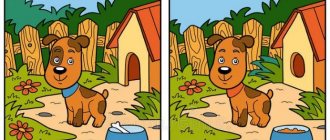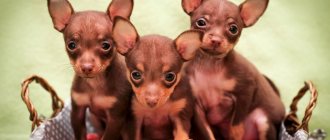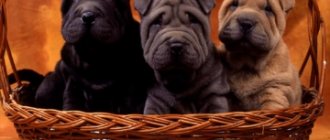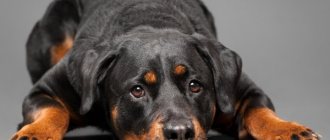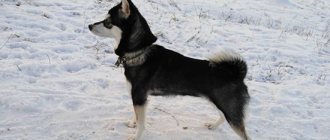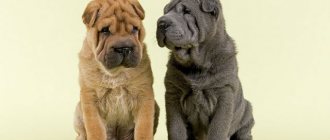MINI-PEI – MINIATURE SHARPEY
I have always been attracted to giants - at the age of 6 I dreamed of a Dogue, at 10 - of a Newfoundland, at 16 - of a Mastino Neapolitan, at 25 - of a Dogue de Bordeaux, at 30 I was amazed by the Irish Wolfhound.
However, I always remembered that a dog that weighs more than me and my loved ones requires careful training, is more difficult to raise, and takes up a lot of space in the apartment. Shar Pei suits me with its size, but sometimes, when there are small puppies at home, no, no, and the thought flashed - oh, if only they would always remain like this! After all, already at 6 months a puppy weighs 15-18 kg, and I really want to extend the time when you can carry them in your arms, cradle them on your lap and carry them on the subway in a cat carrier. The miniature Shar-Pei appeared quite a long time ago, but in most countries it is still a breed, because the FCI standard clearly stipulates the growth of the Shar-Pei. That’s why I never thought about minis, because they cannot participate in exhibitions, which means that all the breeder’s efforts aimed at obtaining a beautiful standard dog will be wasted. But more and more often, standing by the ring when babies (3-6 months) were exhibited, I heard the voices of the audience “oh, if only they remained like this forever!”
Not so long ago, the Russian National Club of the Shar-Pei Breed met all mini-Pei fans and, as part of special breed exhibitions, miniature Shar-Pei . Some minis have already earned the title of National Club Champion. Perhaps the time is not far off when the Mini-Pei will become an independent breed or a tall variety will be identified within the Shar-Pei breed. After all, first toy poodles made their way into the standard, and now poodles with the “harlequin” color have appeared in the rings.
However, the birth of miniks in most cases cannot be predicted. They are usually born from standard parents and often do not differ much from their littermates until 3-4 months. It also happens the other way around - the smallest puppy suddenly begins to grow rapidly at 7 months and by the age of one year becomes a dog of average height. When mating two Mini Pei, the chances of getting Mini Pei puppies are much higher. But they can also slightly outgrow their parents and turn out to be standard. Thus, you can purchase a guaranteed minipea only after a year, when the dog’s growth is complete. In all other cases, the breeder can only assume and hope that after growth the puppy will remain a mini-pei.
The difference between mini and standard is only 1 centimeter. According to the standard, the height of a sharpei is from 44 to 51m, and a mini-pei is a dog below this limit, i.e. from 43cm and below. Although nowadays quite a few Shar Peis are taller than the standard, there are entire regions where the average height of Shar Peis is about 60cm. Compared to such giants, the 43cm Shar Pei really looks miniature. However, if you focus on the average (standard) height of 46-48 cm, then compared to their background, a minipay of 42-43 cm is not so different.
There is a myth that the Mini Pei is a very folded Shar-Pei that looks like a puppy. But this is not true. Dampness (i.e., an abundance of excess skin) is an individual phenomenon, depending on the dog’s constitution, its health (and excessive folds in an adult dog indicate poor health) and even on nutrition. In appearance, the Mini-Pei is no different from the standard Shar-Pei except for its height.
You should be wary of breeders selling puppies as Mini Pei. Sometimes in markets or in photos in advertisements we see unfortunate, starved, rickety puppies that are passed off as minipeas. If such a puppy manages to be released, then over time he will grow into an ordinary dog, but with very problematic health. Some breeders position their sires as mini-pei, hiding the fact that their true size is at the lower limit of the standard.
However, there are more and more fans of mini-pei in our country. Some breeders are engaged in targeted breeding of minis. Perhaps soon the necessary documents will be collected for submission to cynological organizations for recognition of the Mini Pei as a separate breed. There are no mini-puppies in our kennel, although there are dogs 44-45 cm tall, which sometimes produce mini puppies. Young dogs of very small stature are growing up, perhaps soon they will become our producers. However, when selling puppies that we consider miniatures, we will be cautious in predicting their growth for a long time. We hope that the puppy sold by us as an expected MiniPey will be loved by its owners, regardless of whether it grows to be 42cm or 44cm.
| SHAR-PEI KENNEL “SHAT SHYUN” |
A few words about “minipays”.
Not very long ago, just a few years ago, potential buyers periodically began to call me and ask if it was possible to buy a minipei puppy from our kennel? At first, these questions puzzled me, since such a breed does not exist and it is not officially recognized in Russia to this day. Then I began to wonder where people get this information from, why are they so zealously interested in this “breed” and strive to buy just such a dog?
Having rummaged through the Internet, I realized that some breeders have decided to start breeding such dogs, they are actively advertising them as an exact copy of the Shar-Pei reduced several times, passing off an ordinary breeding marriage as a super-mega new breed, charging unrealistically high prices, and so on. The goal, as you understand, is to sell this miracle of nature at a higher price.
One day a girl called me who bought a miniature Shar-Pei a year ago, the puppy was very tiny, very cute, with open big eyes, with a few folds, well, just a doll. Soon she had to leave Moscow for another city and lost contact with the breeder. Quite a bit of time passed and she noticed that the puppy began to grow and develop very quickly - his eyes closed, folds grew, and the puppy began to increase in height very actively. In short, by the time she was one year old, an ordinary Shar-Pei, about 50 cm tall and weighing over 30 kg, was jumping around in her apartment. This is how it happens! It’s good that the girl turned out to be adequate, she loves her dog, despite the size and rather stubborn “male” character! We laughed with her on the phone for a long time about her purchase. Moreover, she paid quite a tidy sum for the puppy!
Recently, miniature Shar-Pei rings have begun to be organized as part of special breed Shar-Pei exhibitions. Yes, indeed, I myself have seen several such specimens with my own eyes; usually teenagers aged 9-10 months are brought into these rings; it is rare to see an adult dog. Do you think this is a coincidence? The probability that the dog will grow to the standard even after 9 months is VERY HIGH!!!
Well, let's return to our potential customers who are craving a minipay and no one else. When I ask what they imagine him to be like, the answer is usually the same: “An adult Mini Pei looks like a Shar Pei puppy—small and crinkly.” When I start explaining that a minipay may not grow to the standard by only 1 cm and be 43 cm tall (according to the standard from 44 cm), they are very surprised! And when I ask if they can distinguish a 43 cm tall Shar-Pei from a 44 cm tall Shar-Pei, usually the person on the other end of the phone simply falls into a stupor. Of course, they will never be able to do this and have never thought about it - the Mini Pei persistently appears to them as a Shar-Pei puppy frozen in growth and nothing else! Even some experts, without using a stadiometer in the ring, will not be able to distinguish 44 from 43 or 42 cm!!! And there is confirmation of this - in Russia there is a female who has repeatedly exhibited in minipei rings and at the same time has several dozen won international titles in standard shar-pei rings.
I would like to summarize my little research.
If the Russian Cynological Federation and the International Cynological Federation recognize this breed, clearly state its standard, indicate height variations, prohibit crossing Shar-Pei and Mini-Pei with each other, if suddenly from the mating of two small Shar-Pei a puppy of standard height is born and grows up - HE WILL BE SELECTED as a breeding dog - only then will these attempts to obtain a fixed miniature in the Chinese Shar-Pei breed make justifiable sense. Now the minis are illegal, although there is undoubtedly interest in them.
In our nursery we have several small Shar-Peis, 44 - 45 cm tall, they are excellent producers and give birth to wonderful children, including small ones. If you really don’t like tall Shar-Peis and you want a Shar-Pei at the lower limit of the standard, come to us and you will definitely buy it!!!
Updated September 18, 2014
© All materials and photographs are the property of the site administrator. ©
Copying and use only with the permission of the administrator or dog owners.
Do mini Shar-Peis exist and what do they look like in the photo?
Recently, miniature dogs have been gaining unprecedented popularity among dog lovers. Given this trend, breeders are breeding mini dogs that are smaller in size compared to their counterparts..
This is how mini Shar-Peis, or, as they are otherwise called, mini-Peis, became popular.
Mini-Peis have been around for quite some time, however, they are not recognized as a separate breed.
Considering the fact that their breeding around the world is quite common, and there are many clubs dedicated specifically to the miniature version of the Shar Pei, experts are talking about the emergence of a new breed variety.
At the moment, mini Shar-Peis are considered a breeding defect, dwarfs who have not grown to the standard size of the breed by the age of one year.
Mini Shar-Peis appear in litters of purebreds. Their parents have standard sizes for the breed.
At first it is difficult to select a mini-pei from a litter; only by 4 weeks of age does it become clear which of the puppies will be mini .
Personality of mini-pei
The Mini Pei is a full-fledged representative of the breed with all the characteristic characteristics, the only difference is the pet’s growth.
A distinctive feature of the character is pronounced leadership qualities . Mini Shar-Peis cannot be called flexible and obedient babies; they require a firm hand from their owner. experienced in raising and training dogs.
Despite the serious expression on their faces, minis are quite cheerful and playful.
They are loyal to their owner, but can be disobedient towards children or elderly people in the family . Mini-pei have peculiar relationships with other animals; they are sometimes cocky towards other dogs and cats.
The Mini Shar Pei has retained the protective qualities of the breed; it is wary of strangers and will protect the property of its owner and himself to the last.
With proper upbringing , a mini-pei will not cause problems; it can become a caring friend, a guard, and show calm and balance .
Character
Shar Peis, regardless of their height, have a very difficult character.
They are convinced leaders and it is extremely difficult to change their point of view on the world.
It is important that the training is carried out by a professional specifically in the field of raising representatives of this breed. They require a special approach.
In relation to other four-legged friends, they can be cocky . At the same time, it doesn’t matter to him whether there is a cat in front of them or a large shepherd dog.
They are loyal to their owner, but in relationships with him they can express their opinions and stubbornness. It is extremely difficult to achieve complete submission.
Therefore, it is so important to teach from a very young age to carry out at least the most necessary commands. They have a difficult transition period, which usually begins at about one year of age.
These pets require a lot of time for communication, playing together, and walking. Socialization should be taken seriously and dealt with in a professional manner. If you are not confident in your abilities, do not want to once again show rigidity in your character, and you do not have that much time to spend on raising and training your dog, then the Shar Pei simply is not for you.
Description of the breed: pros and cons
Like any type of dog that differs in some way from the standard, mini Shar-Peis have their pros and cons.
Among the advantages are the following:
- convenient dimensions, suitable for keeping in a small apartment;
- non-standard appearance;
- good security and protective qualities;
- devotion to the owner and love for the family;
- not picky about care and feeding;
- cleanliness;
- good intellectual qualities.
Among the shortcomings of the mini are::
- tendency to certain diseases;
- stubbornness in character;
- short temper towards other dogs;
- constant desire to communicate with the owner, cannot tolerate loneliness;
- the need for strict education and training.
Basic description of the breed
Despite the fact that Shar Pei is a natural guard, he is not at all aggressive. He is friendly towards his owner, as well as towards strangers, but in case of a threat he will always be able to stand up for the owner. By nature, the dog is playful with a fold, he will never let his owner, or those around him, become sad. The gene for “fighting qualities” flows in the Shar Pei’s blood; do not forget about this, since the dog can start a bloody fight with another dog. The owner is forced to control this so as not to harm his or someone else’s dog. From childhood, Shar Pei needs to be taught to behave on the street.
Advantages:
- Watchman
- Will always protect the owner
- Requires little care
- Flaws:
- Prone to allergies
- Hard to train
Standards:
- Weight: 18–30 kg
- Height: 46–53 cm
- Lifespan: 9–12 years
Description of the breed
Mini-Pei does not yet have a proper history, but this is a matter of time and perhaps today we are present at the birth of a separate genus.
In the meantime, they are closely associated with Chinese Shar-Peis.
There are clubs in different countries of the world dedicated specifically to the mini version of representatives of the genus.
Unfortunately, it is believed that there are still few grounds for registering the breed, but dog handlers are pursuing this event, considering it fair.
Essentially, our heroes are dwarfs. These are those puppies that have not reached the required size by the age of one year and have retained their childlike attractiveness.
The baby is born to parents of a completely standard appearance, and until a month later it is difficult to understand which of the puppies in the litter will become mini. It is possible that all newborns will reach normal size as adults. Usually, the active growth of babies begins from the month, and during this period it becomes clear who will reach the standards and who will be below their minimum mark. This does not mean at all that the difference in height will be striking. The puppy's growth does not stop, it just slows down.
If the usual size ranges from forty-four to sixty centimeters, then the mini version is a height at the withers of up to forty-three centimeters. Other standards are retained:
- The head is large and wide. There is no narrowing towards the muzzle.
- Well developed chest.
- The eyes are small in size, in the shape of a slightly elongated oval. The iris is always dark in color. The expression in the eyes is sad.
- The ears are thick, rectangular, set high, spaced wide apart. The tips of the ears are slightly rounded, directed towards the eyes.
- Limbs straight, parallel, widely spaced.
- The body is compact, almost square in shape.
- The nose is wide and open nostrils.
- The back is straight.
- The tongue and palate are blue or lavender in color. Blue color with pink spots is also allowed.
- The tail is curled into a ring and lies on the back. A distinctive feature of Shar-Peis is their high tail set.
- But the main feature is the folding of the skin. This is caused by a mutation in the HAS2 gene.
- The coat is short, lying close to the body. It is divided into three types: “bear hair”, horse and brush.
- The color palette is quite extensive; they are divided into a group in which black pigment is necessarily present, and a group in which color is completely absent.
Shar Peis, regardless of their height, have a very difficult character.
They are convinced leaders and it is extremely difficult to change their point of view on the world.
It is important that the training is carried out by a professional specifically in the field of raising representatives of this breed. They require a special approach.
In relation to other four-legged friends, they can be cocky . At the same time, it doesn’t matter to him whether there is a cat in front of them or a large shepherd dog.
They are loyal to their owner, but in relationships with him they can express their opinions and stubbornness. It is extremely difficult to achieve complete submission.
Therefore, it is so important to teach from a very young age to carry out at least the most necessary commands. They have a difficult transition period, which usually begins at about one year of age.
These pets require a lot of time for communication, playing together, and walking. Socialization should be taken seriously and dealt with in a professional manner. If you are not confident in your abilities, do not want to once again show rigidity in your character, and you do not have that much time to spend on raising and training your dog, then the Shar Pei simply is not for you.
Standards
If the usual size ranges from forty-four to sixty centimeters, then the mini version is a height at the withers of up to forty-three centimeters. Other standards are retained:
- The head is large and wide. There is no narrowing towards the muzzle.
- Well developed chest.
- The eyes are small in size, in the shape of a slightly elongated oval. The iris is always dark in color. The expression in the eyes is sad.
- The ears are thick, rectangular, set high, spaced wide apart. The tips of the ears are slightly rounded, directed towards the eyes.
- Limbs straight, parallel, widely spaced.
- The body is compact, almost square in shape.
- The nose is wide and open nostrils.
- The back is straight.
- The tongue and palate are blue or lavender in color. Blue color with pink spots is also allowed.
- The tail is curled into a ring and lies on the back. A distinctive feature of Shar-Peis is their high tail set.
- But the main feature is the folding of the skin. This is caused by a mutation in the HAS2 gene.
- The coat is short, lying close to the body. It is divided into three types: “bear hair”, horse and brush.
- The color palette is quite extensive; they are divided into a group in which black pigment is necessarily present, and a group in which color is completely absent.
Maintenance and care
Of course, if a standard dog can reach sixty centimeters at the withers, then the mini, pei, with its forty-two centimeters, will seem like a mini version. The smaller the dog turns out to be, the better it will be for him to live in an apartment, since he will always be able to find a place for himself. Clean your ears and wash your eyes regularly. requires special attention .
Skin care is a must. Clean between folds and keep skin dry. Moisture should not stagnate there, as it promotes the growth of bacteria. When walking in the cold season, your dog should be dressed warmly. It does not have a protective undercoat, and the dog will quickly get sick from hypothermia. For rainy weather, add a raincoat to your pet's wardrobe.
They are prone to food allergies, so the food should only be of a high quality, but this does not guarantee that an allergic reaction to any ingredient will not occur. When choosing natural products for your pet’s diet, it is better to consult a professional or seek help from a veterinarian.
The cost of a puppy will cost from ten to thirty thousand rubles. Its fluctuation depends on the claims of clients, pedigree, and personal characteristics. If an ordinary baby can be taken home at the age of two months, then nuances may arise with mini-pei. At two months you will not yet be convinced that you are buying the mini version. You can only be sure of this if you have a one-year-old dog in front of you.
There are cases where breeders deliberately fed puppies poorly so that they looked smaller than their peers and thus passed them off as mini Shar-Peis. Naturally, when the baby fell into good hands and was fattened, he surprised his owner with his size. You cannot buy a baby of two dwarf parents. Such offspring may be prone to genetic diseases.
Some owner reviews:
“The child asked for a dog, and since we live in an apartment, we decided to buy a mini-pei. We had no idea that this dog had such an unbearable character. The child was constantly bitten, I had to take the dog to.
Price
The cost of a puppy will cost from ten to thirty thousand rubles. Its fluctuation depends on the claims of clients, pedigree, and personal characteristics. If an ordinary baby can be taken home at the age of two months, then nuances may arise with mini-pei. At two months you will not yet be convinced that you are buying the mini version. You can only be sure of this if you have a one-year-old dog in front of you.
There are cases where breeders deliberately fed puppies poorly so that they looked smaller than their peers and thus passed them off as mini Shar-Peis. Naturally, when the baby fell into good hands and was fattened, he surprised his owner with his size. You cannot buy a baby of two dwarf parents. Such offspring may be prone to genetic diseases.
Mini Shar Pei (miniature, dwarf)
Mini-Pei or mini Shar-Pei is not a new, but relatively recently became fashionable, variety of the Chinese Shar-Pei. Let’s make it clear right away that we are not talking about a new breed or an officially recognized type.
This is interesting! In amateur clubs in the USA and Europe, and recently in the RKF (Russian Cynological Federation), separate rings are held for Mini-Peys, but this privilege has literally been wrested from the “canine authorities”. Perhaps fans of the breed will achieve an official division of the breed by height, at least the prerequisites for this already exist.
Appearance and features
Dog lovers remember with fond nostalgia the time when their dog was a cute puppy. Within a year, the baby grows into an adult dog, the trace of childish naivety is erased from his face, he is dexterous and strong, familiar and, one might say, ordinary. When it comes to Shar Peis, the changes are even more contrasting, because the babies are completely covered with folds, grunt cutely and look more like little hippos.
The Miniature Shar Pei does not have its own history, since their origins are completely intertwined with the Chinese representatives of the breed. In the breeding records that have been kept since the beginning of work to restore the breed, there are records of the birth of miniature dogs.
Tips for choosing a puppy
No breeder can guarantee that the size of his graduate will correspond to the mini standard. Such promises are made only by dishonest sellers who do not care about the future of the puppies. The probability of getting mini-dogs in the litter of standard breeding sires is extremely low! When breeders breed two mini-pei (this is prohibited by cynological organizations), the probability increases.
Important! You can purchase a specific mini-pei only if the dog is already one year old. In other cases, you have no guarantee that the dog will not outgrow the cherished 1 cm at the withers.
Be careful and avoid negotiating with breeders who sell thin puppies. Deliberate underfeeding, infection with worms, and the use of unhealthy sires are the tools for obtaining “Mini-Pei puppies.” If you purchase a dog from unsuccessful breeders, most likely the four-legged dog will come to its senses, catch up with its standard in growth, but will have health problems in adulthood.
Important! Don’t chase fashion, don’t take your word for it, make decisions based on common sense! If you decide to get a dog, do not forget about responsibility! A four-legged animal needs care and love, regardless of height, color or compliance with the standard.
Character, content, health
The characteristics of Shar Pei have positive and negative sides. The latter are most often discovered by established owners. The standard describes quadrupeds as active, courageous, independent and rather restive quadrupeds. Shar Pei are prone to escapes, fights with relatives, and food aggression. Problems can appear unexpectedly and at any age. It is important to devote the maximum amount of time to socializing the dog, even if it behaves absolutely adequately.
Until 7-8 months of age, you may encounter attempts to take a dominant position in the family . Usually the pet persistently climbs onto the sofa or bed, growls if it doesn’t like something, follows commands at its own discretion and behaves unpredictably during walks. This period is called the teenage crisis.
In response to the “attacks” of the ward, the owner must show persistence and patience. Shar Peis can and should be trained! Yes, sometimes this task is difficult and seems overwhelming (especially for beginners). If you can't cope, ask for help. Shar Pei is a complex dog, so in almost all major cities you can find a dog handler specializing specifically in this breed.
Is it more difficult to care for a mini pei? The ward needs the same “complex of services” and accessories as a standard Shar Pei:
- Anti-slip mat (to cover the feeding area) and an adjustable stand for bowls.
- A spacious bed with sides - the dog should be able to lie down without resting his paws and head.
- Comfortable harness and durable leash.
- Soft rubberized brush and shampoo for sensitive skin. Coat cleaning is carried out once a week, during shedding, every day (this is in your interests). Bathing your dog with shampoo is important as it gets dirty, but not more than 4 times a year. If your pet gets dirty with dust or soil, it needs to be washed with clean water.
- Accessories for cleaning teeth , especially relevant for dogs with malocclusion.
- Ear cleaning solution and cotton swabs - the procedure is carried out 1-2 times a month.
- Guillotine claw cutter.
- A set of towels for wiping folds and face after eating.
Tip: use a harness for walking and a wide collar for training. The harness does not hinder the dog’s movements and does not affect the comfort during walks. The collar can catch the neck, which can lead to grunting and wheezing.
Like their standard counterparts, mini-pei are prone to food and non-food allergies. The first thing the disease affects is the condition of the skin and coat. Further, the dog’s eyes and nose begin to run, and sometimes otitis media develops. Balanced feeding of your dog is the key to health. Most established owners are inclined towards the natural type of feeding. Foods to which the four-legged animal has an allergic reaction are excluded from the diet.
Non-food allergies are virtually invincible because it is very difficult for the owner to figure out what exactly the dog’s body is reacting to. When the immune system is in an excited state, the Shar Pei can react sharply to foods to which it is not allergic. Veterinarians recommend spending time and energy and trying to choose a natural menu for your mini-pei. If the attempts are unsuccessful or the dog’s health does not withstand the “experiments,” the dog is switched to high-quality industrial food.
Dog care
Shar Peis are clean dogs, so brushing their coat once a week is enough. The brush should have short bristles or rubber. Several times a week you need to wipe the eyes and folds on the face. Bathe no more than twice a year. The dog also needs daily walks and physical activity. Diseases: glaucoma, allergies, otitis media, mastocytoma.
Feeding Like all dogs, Shar Pei can be fed both dry and natural food. Do not mix food under any circumstances, as mixed food ruins the dog’s health. If you feed your pet dry food, you should buy high-quality food, since inexpensive food may not contain vitamins. With natural food it is much easier, since the owner knows what food he is giving and what vitamins are present. In order to create a dog’s diet, you need to contact a veterinarian.
Mini Shar Pei
The appearance of mini-Pei dogs is a completely natural phenomenon. Against the backdrop of urbanization, it is not surprising that the popularity of small breeds is growing. Indeed, keeping a small pet in an apartment is much more convenient than keeping a large dog. Breeders and breeders have taken into account the needs of dog breeders and today you can buy a dwarf Spitz, pinscher, terrier, miniature King Charles spaniel or poodle. The same thing happened with Chinese Shar-Peis. Many breeders began to strive to produce offspring with smaller individuals. But until the complete formation of the breed and recognition of the dwarf Shar-Pei has occurred, they remain officially unrecognized.
Origin story
Shar Peis are representatives of an ancient breed, the roots of which go back so deep into centuries that scientists have still not been able to figure out the origin of these dogs. There is evidence that, by order of the Great Chinese Emperor, all stud books associated with such information were burned. According to one theory, the ancestors of Shar Peis are mastiff-like dogs and chow chows. It is based on individual elements of the physique, skeletal system and character traits. But it is known for certain that the breed has existed for 3 thousand years.
Due to the isolation of China and the decline in the popularity of dogs for fighting, which is how Shar Peis were used at that time, the breed was on the verge of extinction in the 50s of the last century. Only 20 years later, several purebred puppies were brought abroad, where the process of reviving the breed began. Already in 1976, the first official breed standard appeared.
In Russia, these dogs with folds became known in the 90s. Gradually, Shar-Pei aroused great interest not only among dog breeders, but also among breeders. As for miniature pei, they do not have their own deep history, except that in some stud books there is a mention of the appearance of smaller offspring.
In the 90s of the last century, a club of miniature pei lovers appeared in Europe, which included breeders and dog breeders from Italy, France, Portugal, and Spain.
Description of the breed
Unfortunately, today mini-pei do not yet have their own standard - individuals must meet general requirements. They are distinguished from standard representatives of the species only by their height. Moreover, the difference can be only 1 cm. The height of a standard Shar-Pei varies between 44-51 cm, and individuals with a height of 43 cm and below are considered mini-Pei. The most optimal indicator is 35 cm, the minimum is 28 cm. Weight is not specified; if the proportions are observed, miniature individuals have shorter limbs than standard ones.
Otherwise, the dwarf Shar Pei retains the appearance and parameters of the breed representative:
- the head is large, wide, without narrowing towards the muzzle;
- the nose is wide, with well-opened nostrils;
- there is a breed feature - the palate and tongue are colored blue or lavender, in some dogs they may be covered with pink spots;
- the chest is powerful, wide;
- the eyes are small, oval, with a dark iris; the description of the gaze often consists of the following adjectives - sad, serious and even stern - this is what makes it so because of the folded skin hanging over the forehead;
- the ears are set high, fleshy, rectangular, the tips are rounded;
- limbs are widely spaced, stand parallel to each other, with strong bones and developed muscles;
- the tail is set high, curled in a ring and lies on the back.
All Shar-Peis have a compact, almost square build, the back is muscular, the loin and croup are strong. Thanks to mutational changes in genes, dogs of this breed have acquired unusual, folded skin.
Coat and possible colors
There are three types of Shar Pei coat:
- Khorsovaya. A short, hard awn, the length of which does not exceed 1 cm. This is exactly the kind of hair that representatives of the breed had before breeding work.
- Brashevaya. As a result of the addition of new blood, dogs were obtained with a awn length of 1 to 3 cm. Thanks to this coat, individuals look more powerful and strong. They are not recognized at home in China.
- Bear fur. Length no more than 3 cm, passed on to offspring only if both parents have a recessive gene of this type. Not included in the standard.
As for colors, there are dogs with black, fawn, red, cream, sable, blue, lilac, and isabella hair. Dogs with dilute colors are popular - chocolate, red, cream, Isabella.
Albinos, spotted and black-backed dogs are culled.
When looking at the serious face of the mini-pei, it may seem that this is a sad dog who is of little interest to those around him. But any owner of such an unusual dog will say that his pet is the most cheerful, loving and tactful representative of the canine world. It should be borne in mind that the miniature Shar Pei is not without stubbornness and willfulness - qualities inherent in standard dogs. Already from the age of 3 months, the puppy begins to figure out what place it occupies in the house and whether the owners want to make room on the hierarchical ladder. It is important to take into account the dog’s character and not miss the moment of initial education.
You should not expect 100% obedience - the pet will not obey younger family members and older relatives, since their social status is lower than that of the owner. These dogs get along with children, but do not allow unnecessary liberties, therefore, you should not take the puppy to a house where there are children. And in any case, the child should be explained how to communicate with the animal and what actions are best avoided. The Mini Shar Pei needs a person who has a strong character, steadfastness and patience.
Pei have a well-developed protective instinct, therefore, they are wary of strangers. The dog will not announce the entire neighborhood with loud barks, sensing the approach of strangers, but will greet you unkindly. He can live amicably with other pets in the same territory, but only if he grew up with them. A feature of Shar Peis is weakened peripheral vision associated with voluminous eyelids. Because of it, dogs are afraid of sudden touches.
Suitable nicknames
As a rule, offspring that have parents with a pedigree receive a name upon registration and the baby goes to the new owners with it. If a puppy is bought from random sellers, then the owners have to come up with a nickname.
The following nicknames are suitable for boys of this breed: Archie, Acker, Butch, Bruno, Barney, Bingo, Bruce, Dexter, Diego, Joker, Zeus, Cain, Kurt, Cosmo, Lucky, Leo, Monty, Oscar, Pike, Punch, Roni, Reiko , Rolf, Sancho, Simon, Snack, Spikey, Theo, Hulk, Hugo, Charlie, Chet, Juan, Howe, Khaki.
The girl can be called: Adele, Bessie, Bentley, Vega, Venus, Gabi, Ju, Zara, Zita, Kenya, Keri, Laura, Molly, Mimi, Nancy, Olivia, Penny, Pixie, Rowe, Tori, Thea, Stecy, Simone, Fanta, Flash, Helga, Chita, Shelly, Amber.
Appearance of a dwarf shar pei
The breed standard determines that the height of a healthy Shar Pei is 44-50 cm. Mini Pei, on the other hand, do not exceed 43 cm at the withers. The minimum height is 28 cm, the average is 35 cm. They weigh no more than 25 kg.
The limbs are smaller than those of standard-sized dogs. Their physique resembles a square. The chest is wide and well developed. The back is muscular. The tail is curled into a ring and lies on the back. The muzzle is wide, the tongue and palate are blue.
Photo from Instagram account sharpeigram
Some breeders say that Dwarf Shar-Peis remain puppy-like and furrowed, but this is not true. Excess skin manifests itself individually. It depends on the dog’s physique, health and diet. Both standard and dwarf Shar-Peis can be covered in folds even as adults. This is the result of poor health, the presence of hidden diseases or improper care.
The color is varied: cream, chocolate, lilac, blue, red, black, etc. The coat is short and comes in several types:
- bearish: 2.5-3 cm, not included in the standard. Its manifestation is determined by a recessive gene;
- brush: 1-3 cm, dense, gives the dog a powerful, strong appearance. In some countries this type of coat is not recognized because it was created by mixing with other breeds;
- horsehair: 0.5-1 cm, the wool is hard to the touch. Initially, before breeding work, all purebred representatives of the breed had this type of coat.
The character of Mini Peys corresponds to the characteristics of the breed standards: they are active, energetic, and confident. They are more attached to their owner and have a hard time withstanding separation. Sometimes they show aggression towards other breeds and animals.
Care and maintenance
Miniature representatives of the Chinese breed have a number of advantages that make it easier to keep a pet in a house or apartment:
- clean and understanding;
- they are modest in size;
- do not shed;
- don't smell like dog.
Shar-Peis are also suitable for aviary keeping, as they tolerate high temperatures and frosts well, but the aviary must be well equipped. It is important that the dog is not in a draft.
Caring for a folded pet consists of standard procedures:
- combing wool with a massage brush;
- trimming nails as needed;
- wiping the eyes with a napkin soaked in boiled water;
- treating the ears with a damp cotton pad.
Pei are bathed infrequently, only when required. The weak point of dogs of this breed is the ears; if water penetrates the ear canal, inflammation cannot be avoided. Walk mini-pei 2 times a day; walks can be active, but without excessive physical exertion.
Features of the diet and feeding regime
There are 3 types of feeding and all of them are acceptable for mini pei:
- Natural. This diet is called the carnivore diet - 80% of the diet consists of raw foods containing animal proteins. The rest of the menu is grated vegetables, they are served raw. You should not include beets and potatoes in your Shar Pei's menu. Twice a week it is recommended to feed an adult pet cottage cheese and fermented milk drinks - natural, without sugar or other additives.
- Artificial. The pet is fed exclusively with premium or super premium industrial food.
- Mixed. The dog eats natural products and industrial food: in the morning he is given a dry diet, and at the second feeding - fresh meat or offal.
When choosing a diet, you should take into account the Shar Pei's tendency to allergies.
How to raise and train
Beginners in dog breeding should not get a Shar Pei; it requires an experienced owner. The dog's eastern calmness and stubbornness cause a lot of problems during training; he quickly remembers commands, but may simply refuse to carry them out. To prevent your dog from growing up wayward and disobedient, you should adhere to the following rules:
- You should be involved in raising and socializing a puppy from the first days of his arrival in the house;
- at all stages it is necessary to show patience and perseverance;
- train Shar Peis from 3-4 months of age, paying special attention to softening the dominant character trait;
- An important point is socialization - you should take your pet for walks to new places, introduce him to people and animals, and take him on transport.
It is prohibited to use rudeness, physical force, or aggression. The Shar Pei must have one trainer; other people (except the dog handler) should not be allowed in this matter.
Diseases and life expectancy
Standard representatives of the breed live on average from 10 to 12 years, as for mini Shar-Peis, this data also applies to them. They have strong immunity, but they also have a tendency to certain diseases:
- allergies;
- eye diseases;
- ear infection;
- entropy (turned eyelids) is hereditary.
With proper care and maintenance, a pet can live longer.
Causes of short stature and common diseases
The foundation of health and growth is laid in the uterine and suckling periods (from birth to one and a half months). If there are violations, the dog grows smaller than the established size. It is impossible to determine dwarfism immediately after birth. The lag begins at the age of 2 months, less often - after six months.
The main reason why a dog does not reach the desired height is a deficiency of growth hormones. It is produced by the endocrine gland - the pituitary gland. With congenital underdevelopment of the pituitary gland, from the first months the Shar Pei begins to lag behind other puppies in the litter in height.
Dwarfism can occur due to other reasons. Their list is long:
- diseases of the cardiovascular system;
- kidney diseases;
- dropsy of the brain;
- poor nutrition and lack of vitamins, microelements and macroelements in the body;
- hereditary deficiency of growth hormones;
- deficiency of enzymes involved in protein synthesis;
- diabetes;
- various hormonal disorders.
Both standard and small Shar-Peis have an average life expectancy of 10-12 years. For dogs with good heredity, this is 14 years. If you are prone to diseases – 9 years.
Small dogs can boast of strong immunity, but they are prone to certain diseases:
- allergic reactions;
- skin diseases;
- disorders of the thyroid gland;
- ear infections;
- eye diseases, including entropion.
The Mini Shar Pei needs regular veterinary check-ups, proper nutrition and regular exercise to reduce the risk of developing diseases. Visits to the veterinary clinic between the ages of 6 months and 1.5 years are especially important to determine if the dog has any other problems other than short stature.

